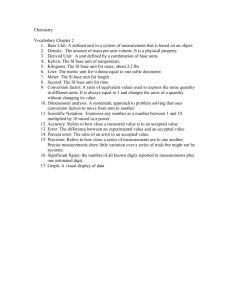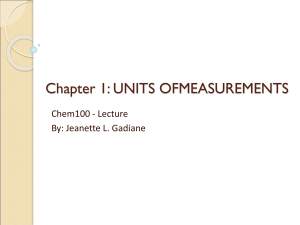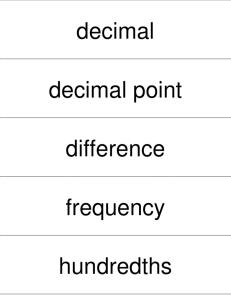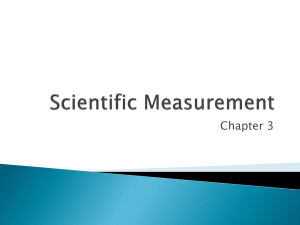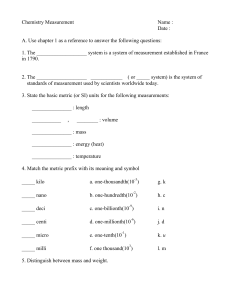Chemistry I - Chapter 3 - Vocabulary & Main Ideas
advertisement
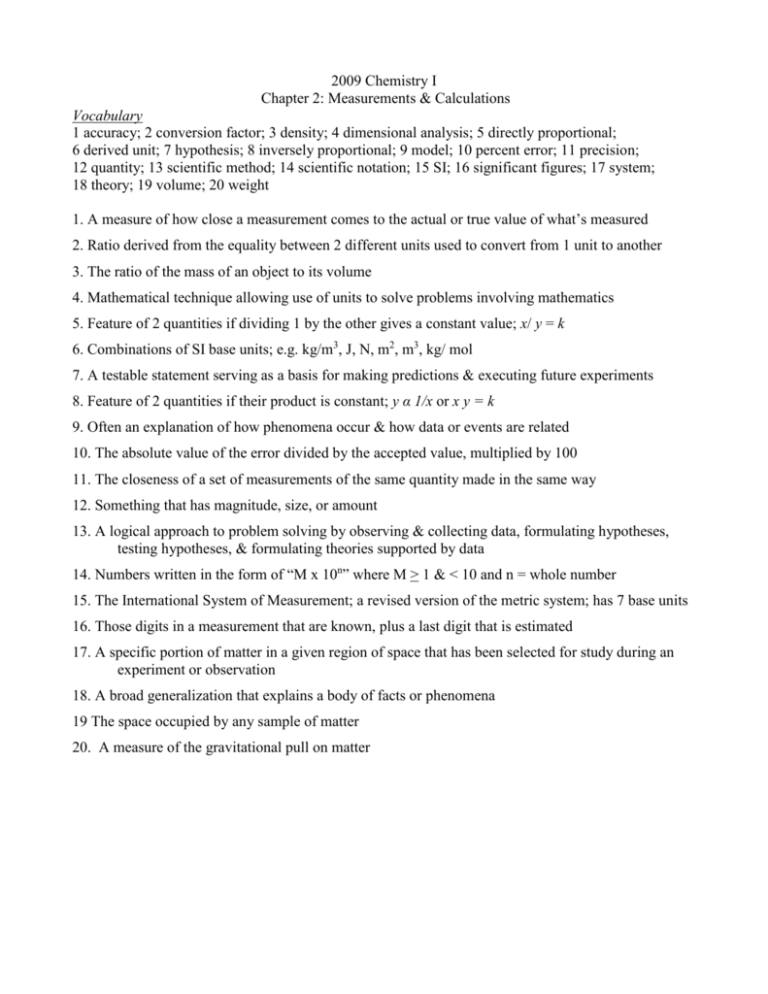
2009 Chemistry I
Chapter 2: Measurements & Calculations
Vocabulary
1 accuracy; 2 conversion factor; 3 density; 4 dimensional analysis; 5 directly proportional;
6 derived unit; 7 hypothesis; 8 inversely proportional; 9 model; 10 percent error; 11 precision;
12 quantity; 13 scientific method; 14 scientific notation; 15 SI; 16 significant figures; 17 system;
18 theory; 19 volume; 20 weight
1. A measure of how close a measurement comes to the actual or true value of what’s measured
2. Ratio derived from the equality between 2 different units used to convert from 1 unit to another
3. The ratio of the mass of an object to its volume
4. Mathematical technique allowing use of units to solve problems involving mathematics
5. Feature of 2 quantities if dividing 1 by the other gives a constant value; x/ y = k
6. Combinations of SI base units; e.g. kg/m3, J, N, m2, m3, kg/ mol
7. A testable statement serving as a basis for making predictions & executing future experiments
8. Feature of 2 quantities if their product is constant; y α 1/x or x y = k
9. Often an explanation of how phenomena occur & how data or events are related
10. The absolute value of the error divided by the accepted value, multiplied by 100
11. The closeness of a set of measurements of the same quantity made in the same way
12. Something that has magnitude, size, or amount
13. A logical approach to problem solving by observing & collecting data, formulating hypotheses,
testing hypotheses, & formulating theories supported by data
14. Numbers written in the form of “M x 10n” where M > 1 & < 10 and n = whole number
15. The International System of Measurement; a revised version of the metric system; has 7 base units
16. Those digits in a measurement that are known, plus a last digit that is estimated
17. A specific portion of matter in a given region of space that has been selected for study during an
experiment or observation
18. A broad generalization that explains a body of facts or phenomena
19 The space occupied by any sample of matter
20. A measure of the gravitational pull on matter
Main concepts – Chapter2 - Chemistry I
Scientific Method
I. Approach
A. Observing
1. Use of 5 senses
2. Use of instrumentation
3. System – selected region of focus for experimentation
4. Formulate hypothesis – testable statement attempting to explain observations
B. Researching current knowledge about chosen system/ proposed hypothesis
1. Publications
2. Presentations/ conferences
C. Experimentation
1. Controls – experimental conditions that remain constant
2. Variable – any condition that changes
a. Independent variable (I.V.)– The condition/factor being tested for an effect
b. Dependent variable – Condition/ factor being measured as a result of I.V.
D. Theorizing
1. Formulated upon successful outcome of predictions
a. Basis for constructing a model (visual, verbal, &/or mathematical)
2. Broad generalization seeking to explain a body of facts/ phenomena
a. Strong predictive powers
b. Sweeping applications
Measurements
I. Types
A. Qualitative
1. Descriptive, non-numerical
2Subjective - does not have consensus
B. Quantitative
1. Definite form, usually numerical
2. Can be compared with others’ data
3. Only as reliable as the instrument of measurement
II. Expression
A. Scientific Notation
1. Written as product of a coefficient and an exponent of 10 (10 raised to a power)
a. Coefficient is a real number, >1 and < 10
7.25 x 105 = 725,000
6.1462 x 10-2 = 6.1462 x 1/100 = 6.1462 100 = 0.061462
1.43 x 100 = 1.43 x 1 = 1.43
b. The exponent is also a whole number, negative to positive infinity
(+) indicates the number of times the coefficient must be multiplied by 10
(-) indicates the number of times the coefficient must be divided by 10
2. Mathematical manipulation
a. Multiplication: multiply coefficients and add exponents
[2.54 x 106] x [2.1 x 10-4] = (2.54 x 2.1) (106+(-4)) = 5.334 x 102
b. Division: divide the coefficients and then subtract the denominator’s exponent from
the exponent of the numerator
[2.54 x 106] / [2.1 x 10-4] = (2.54 / 2.1) (106-(-4)) = 5.334 x 1010
c. Addition or subtraction: make the exponents the same power
[5.4 x 103] + [6.0 x 102] = [5.4 x 103] + [0.6 x 103] = [5.4 + 0.6] x 103
[5.4 x 103] - [6.0 x 102] = [5.4 x 103] - [0.6 x 103] = [5.4 - 0.6] x 103
III. Uncertainty in measurement
A. Accuracy
1. Measure how close a measurement comes to the actual or true value
2. The goal is to approach/ reach the “accepted value”, i.e. what is considered right
B. Precision
1. Measure how close a series of measurements are to one another
2. Is a function of reproducibility
C. Error
1. The difference b/w the accepted value & the experimental (lab) value
2. Error = experimental value - accepted value
3. Percent error ={absolute value of error divided by the accepted value} x 100%
a. Calculate the % Error for the boiling point measurement of water
% Error = [(99.1 oC - 100.0 oC) / 100.0 oC] x 100 %
b. Positive % error if the accepted value is < lab value; neg % if > lab value
D. Significant Figures
1. Includes all the digits in a number that are known, plus a last digit that is estimated
a. Every non-zero digit is assumed to be significant.
24.7 m or 0.775 or 648 all have 3 significant figures
b. Every zero found between other significant figures is also significant
36005 cm or 3.022 ml or 3000.8 have 4 significant figures
c. Left-most zeroes appearing in front of significant figures are not significant.
These act merely as placeholders, as illustrated with scientific notation.
0.00048 or 0.36 or 4.7 or 0.00000000015 have 2 significant figures
4.8 x 10-4 or 3.6 x 10-1 or 4.7 x 100 or 1.5 x 10-10
d. Right-most 0’s left of the decimal point are not significant if they’re placeholders
3000 m or 7000 ml or 0.4 g has only 1 significant figure
e. Zeroes at the end of a number & to the right of a decimal point are always significant.
43.00, 1.010, & 9.000 have 4 significant figures.
f. Counted items & exactly defined quantities have unlimited number of sig figures.
23 people, 60 seconds = 1 minute
2. Rounding In Calculations
a. Multiplication & dividing
Round to the least significant figure of the numbers being used
(5.4)(7.7)= 41.58 BUT ONLY HAS 2 S.F., so can only say is 42!
If the digit to the right of the last significant digit is <5, drop it
Round 56.312 to 4 S.F. = 56.31
If the digit to the right of the last significant digit is > 5, round up 1
Round 56.315 to 4 S.F. = 56.32
b. Addition & subtraction
Round to the same # of decimal places as the # with least # of decimal places
(NOTE: # decimal places is NOT EQUAL to # digits)
12.52 + 349.0 + 8.24 = 369.76, but 349.0 has only 1 decimal place, so= 3.698 x 102
V. International System of Units (SI)
A. Base Units
a. Meter (m) - length
b. Kilogram (kg) - mass
c. Kelvin (K) - temperature
d. Second (s) - time
e. Mole (m) - amount of substance
f. Candela (cd) - luminous intensity
g. Ampere (A) - electric current
B. Derived Units
a. Cubic meter (m3) - volume
b. Grams per cubic centimeter (g/cm3) or grams per milliliter (g/ml) - density
c. Pascal (Pa) - pressure
d. Joule (J) – energy – force x length = Newton meter (Nm)
e. Molar mass (M) – amount in grams/mole
C. Non-SI units
1. Liter (L) - volume = vol. of cube 10 cm along each edge = (10 cm)3 = 1000 cm3 = 1000 ml
2. Degrees Celsius (oC) - temperature
3. Atmosphere (atm) - pressure
4. Millimeters of Mercury (mm Hg) - pressure
5. Calorie (cal) - energy
D. Commonly used prefixes in the metric system
1. T – tera – 1012 = 1,000,000,000,000
2. G – giga – 109 = 1,000,000,000
3. M - mega - 106 = 1,000,000
4. k - kilo - 103 = 1,000
5. h – hecto – 102 = 100
6. dk - deca - 101 = 10
7. d - deci - 10-1 = 1/10
8. c - centi - 10-2 = 1/100
9. m - milli - 10-3 = 1/1000
10. - micro - 10-6 = 1/1,000,000
11. n - nano - 10-9 = 1/1,000,000,000
12. p - pico - 10-12 = 1/1,000,000,000,000
13. f – femto – 10-15 = 1/ 1,000,000,000,000,000
E. Units of volume
1. The space occupied by any sample of matter
a. Liter is common unit of volume
b. Volumes will change with temperature; use 25 oC as standard temperature
F. Units of Mass
1. Mass = a measure of the quantity of matter
a. The kilogram (kg) is standard mass
b. A kg was originally defined as the mass of 1 L of H2O @ 4 oC
c. A gram (g) is 1/1000 of a kilogram
2. Weight = a force that measures the pull on a given mass by gravity
VI. Density
A. Density
1. Density is the ratio of the mass of an object to its volume
2. Density = mass / volume; typically, d = g/cm3
B. Specific Gravity
1. Comparison of the density of a substance with the density of a reference substance
a. Comparisons are usually at the same temperature
b. Specific density = density of X (g/cm3)
density of H2O (g/cm3)
c. Note that the units cancel out, so specific gravity has no units
2. Measured
a. Hydrometer is device used to measure specific gravity
b. Common uses
Urine is checked in diagnosing diabetes
Radiator fluid is checked to determine % antifreeze
Car batteries are checked to determine % acid
VII. Conversion Factors
A. Allows conversion from 1 unit to another
B. Relies on equality between 2 different units; e.g. 4 quarters= 1 dollar = 10 dimes
C. Dimensional analysis
1. quantity sought = quantity given x conversion factor
2. In conversion factors, have your desired outcome in the numerator if multiplied &
in the denominator if you are dividing it into another number
e. oC + 273.15 = K [ Note the lack of a degree symbol.]
VIII. Temperature
A. Measuring
1. Temperature determines the direction of heat transfer
2. Heat moves from the area of greater temperature to area of lower temperature
3. Almost all substances expand with an increase in temperature & contract with a decrease
a. Water is the exception
b. Mercury in thermometers expands with increased temperatures
c. Bilayer metals in thermostats respond with expansion to different degrees
B. Scales
1. Celsius
a. Named after Swedish astronomer Anders Celsius
b. Based on 2 reference points: Freezing (0 oC) & Boiling (100 oC) Points of pure water
c. The difference between B.P. & F.P. was divided equally into 100 intervals
2. Kelvin
a. Named after Scottish physicist & mathematician Lord Kelvin
b. Also called the absolute scale
c. Freezing point of water is set at 273.15 K & boiling point at 373.15 K
d. Absolute zero Kelvin, 0 K, equals -273.15 oC
IX. Proportionality
A. Directly proportional
1. y α x or y/x = k or y = k x
2. Graphing x versus y will give you a straight line with a positive slope passing thru the origin
B. Inversely proportional
1. y α 1/x or x y = k
2. Graphing x versus y will give you a hyperbola curve
